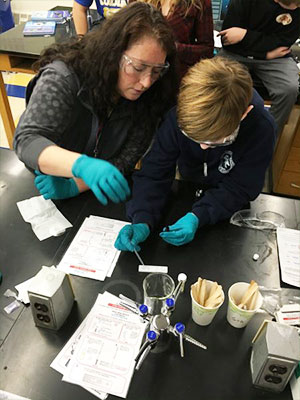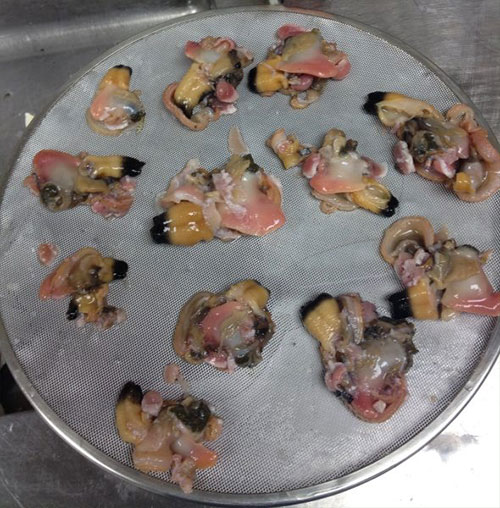
Alaskans try to combat death by marine toxinsBy PAULA DOBBYN
March 02, 2018
A group of Alaskans - including state officials, tribes, nonprofit organizations and researchers - have recently come together to try to combat these marine toxins. The goal is to keep Alaskans who collect and eat shellfish from the beach as safe as possible with up-to-date information.
Given Alaska’s sweeping coastline - nearly 34,000 miles - that’s a tall order. But members of the newly formed Alaska Harmful Algal Bloom Network hope that through information sharing and technology, they can make a dent. The job of keeping Alaskans safe from toxic shellfish starts with phytoplankton, tiny algae found in fresh and salt water. Scientists consider phytoplankton the building blocks of the aquatic food web. But phytoplankton can become deadly if sunlight, water temperature and ocean nutrients line up in a certain way. In those cases, phytoplankton rapidly multiply, or “bloom,” and may become poisonous, creating a toxic soup that can spread for miles. Animals that ingest the soup can become sick or die, or they can hold onto a toxin for years. When humans eat an animal that contains a toxin, they can develop symptoms of paralytic shellfish poisoning, a notorious illness that can be fatal. Some of these naturally occurring toxins can be more powerful than cyanide. These poisonous stretches of water are called “harmful algal blooms.” They are becoming more common and showing up in parts of Alaska where they were never prevalent before, a trend scientists say may be associated with climate change. “It seems to bloom more often in warmer water. The jury is still out but all indications are that with warmer waters in Alaska, we are likely to see more harmful algal bloom events,” said Ginny Eckert, a University of Alaska Fairbanks professor. A public health threat Shellfish harvesting is common in Alaska. Many people do it for fun and food. Others harvest for cultural reasons. With much of the state’s population living along the coast, harmful algal blooms pose a serious and growing health threat. “People have become scared and some have quit harvesting,” said Kim Wickman. Wickman coordinates environmental work for the Wrangell Cooperative Association, a federally recognized tribe in Southeast Alaska’s Inside Passage. Wickman monitors the water and shellfish at two popular harvesting spots in Wrangell. “We want people to have the information they need to make a proper decision,” she said. Producers of commercially harvested shellfish in Alaska are required to have their products screened for toxins. But state officials say they lack enough resources to pay for recreational or subsistence testing. As a result, Alaskans who harvest for themselves or their families were basically on their own until recently, when the Sitka Tribe of Alaska created a testing lab to monitor shellfish and phytoplankton. Anyone in Alaska can send a sample in and have the shellfish tested for $50. Never a safe month Although the Sitka lab will test shellfish, some Alaskans don’t know about it or may feel they can’t afford it. Others simply follow the theory that if shellfish is harvested in a month containing the letter “R” then it’s safe, meaning September through April. But that’s not true. “There’s never a safe month. Unless your shellfish is tested by a professional lab, you can’t guarantee that you won’t be exposed to toxins,” said Julie Matweyou, a UAF associate professor in Kodiak who studies harmful algal blooms.
Since 1993, four people have died and more than 120 have reported symptoms after eating clams, mussels, cockles and scallops they harvested from Alaska beaches. The symptoms of paralytic shellfish poisoning include tingling of the lips and tongue and trouble breathing. Matweyou, who also works for Alaska Sea Grant, is developing a hand-held, rapid field test for people to use at harvest sites to gauge the safety of shellfish. She researches paralytic shellfish poisoning and raises public awareness through outreach with adults and school-age children. Old problem, new locations Harmful algal blooms are nothing new. “There was a mass mortality in the late 1770s when over a hundred Aleut hunters near Sitka died from eating mussels. But these blooms are showing up in new places. All indications point to a future where these blooms are more common,” said Eckert, associate director of research for Alaska Sea Grant. Harmful algal blooms are the suspected culprit in a variety of recent marine mammal deaths and seabird die-offs, which pose food security concerns for residents who depend on these animals for subsistence. Residents of Southeast Alaska are so concerned that 16 tribes are now involved in a testing program developed by the Sitka Tribe of Alaska, called Southeast Alaska Tribal Ocean Research. Weekly samples are taken from beaches to monitor phytoplankton activity and to test shellfish for toxins. The data is analyzed at the tribally run lab in Sitka, and the results are shared on the internet. The group will never categorically say whether it’s safe to harvest from a particular beach or not. But if samples come back hot, the public will be warned. “We provide information to harvesters so that they can make more informed decisions about where and whether to collect shellfish. That way folks can see what’s going on from Yakutat to Metlakatla,” said program manager Chris Whitehead. Vast coastline Rosie Robinson, a research technician who works at the Kachemak Bay Research Reserve in Homer, tests local shellfish and sends samples to the Sitka lab. Last summer she sounded the alarm about two likely cases of paralytic shellfish poisoning. “It’s wasn’t so extreme that they went to the hospital. But it was very concerning. I went to the areas where they were harvesting and took samples of shellfish. The samples came back very toxic,” Robinson said. People involved in shellfish testing for recreational or subsistence harvesters note that the current testing process has limitations and that the results can never be interpreted as a guarantee. But some say it’s a step in the right direction. And, over time, they hope a more definitive test will emerge. “Our coastline is vast. It’s hard to sample everywhere,” said Eckert. “Ultimately we hope to be able to forecast where the toxic blooms are happening so Alaskans who harvest shellfish recreationally and for subsistence can know which beaches to avoid and at what time. Conditions can shift from day to day.”
On the Web:
Representations of fact and opinions in comments posted are solely those of the individual posters and do not represent the opinions of Sitnews.
|
|||||

